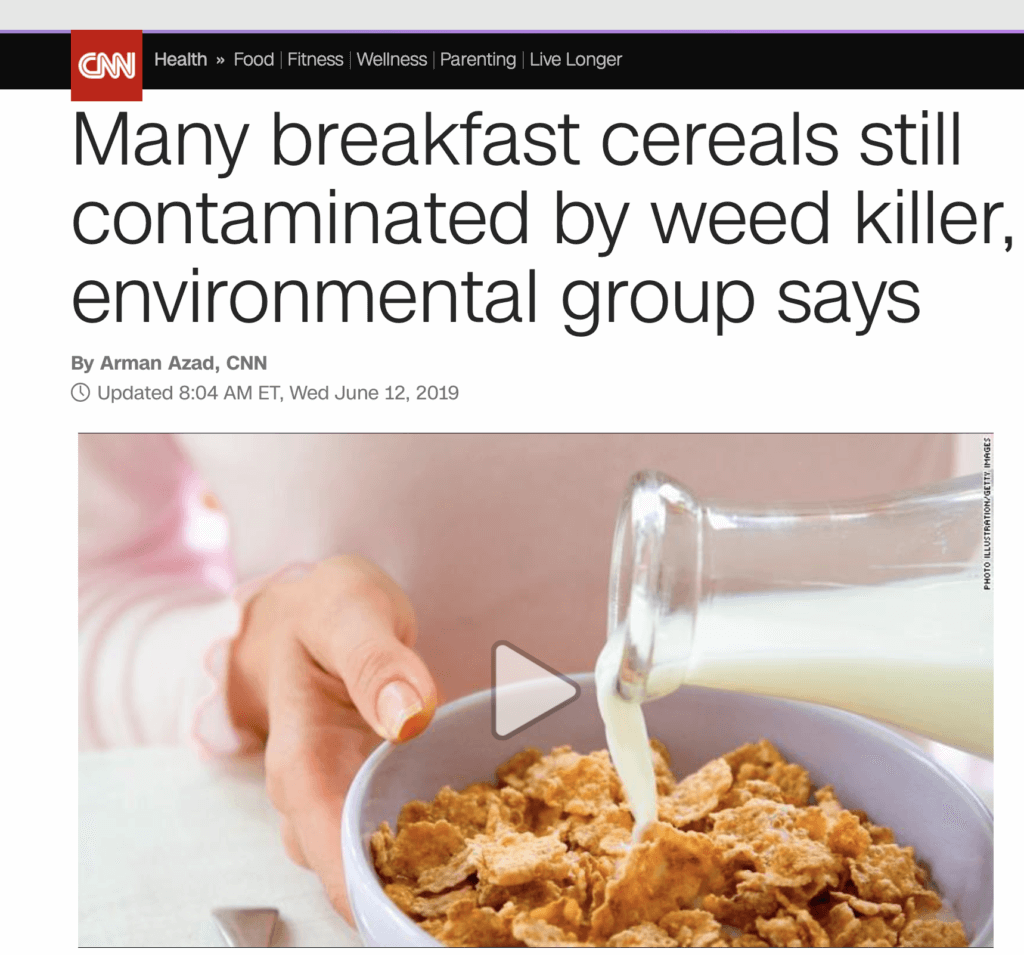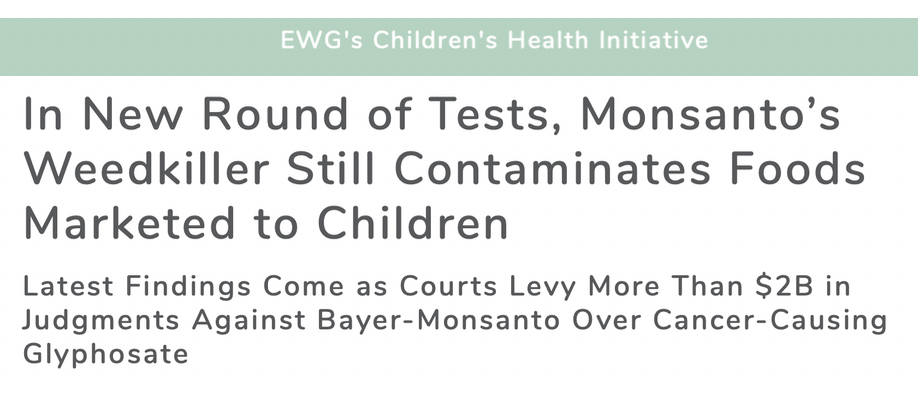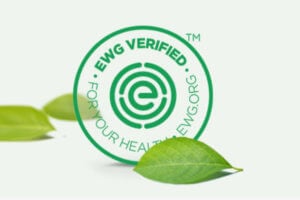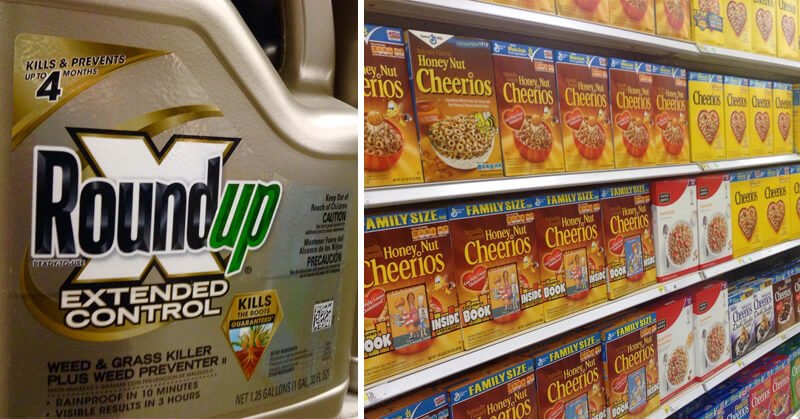On June 12 2019, the organic industry-funded Environmental Working Group (EWG) issued a news release that claimed, “Major food companies like General Mills continue to sell popular children’s breakfast cereals and other foods contaminated with troubling levels of glyphosate, the cancer-causing ingredient in the herbicide Roundup.”
EWG’s announcement is the third of its kind focusing on the alleged dangers of glyphosate residues in our food. It was immediately trumpeted by fringe activist groups—that’s par for the course—but was also covered, almost entirely uncritically, by mainstream sources, such as CNN:
What’s the news here?
Like its predecessors, released in July and October 2018, this EWG ‘study’ was based on a “round of tests” that was not peer reviewed by independent experts. Its scientists claimed that they found dozens of instances in which food it tested did not pass its “children’s health benchmark” for assessing potential exposure level hazards.
EWG did not mention that its ‘benchmark’ is entirely made up, has no clear scientific basis and is at odds with historically established and globally recognized benchmarks used by regulators in every country. The EWG “safety threshold” is 100 times lower than even the most conservative cut-off established by oversight agencies around the world, including the EPA. Curiously but not surprisingly considering EWG’s historical willingness to distort science, the threshold it settled upon just ‘happens’ to coincide with the infinitesimally trace amounts of glyphosate it found on Cheerios.
As justification for these scare tests and reports, EWG cited a 2015 International Agency for Research on Cancer (IARC) review of glyphosate, which concluded that workers exposed to glyphosate could face cancer threats, classifying the long-used herbicide as “probably carcinogenic to humans.” Sounds scary, but it’s not. The mainstream science community has sharply criticized the UN sub agency for its antiquated study methodology and its decision to exclude the overwhelming body of research that didn’t support a link between glyphosate and cancer, including a state-of-the-art longitudinal study of more than 50,000 people who regularly applied the herbicide and had no pattern of unusual cancer-related health issues. [Read GLP’s report examining IARC’s research and other studies on glyphosate’s potential health hazards]
Recent reports from the Centers for Disease Control and the Environmental Protection Agency, released in April and May 2019 respectively, confirmed the global consensus of pesticide researchers and regulators that glyphosate poses no cancer risk as currently used. Every major regulatory and oversight body in the world—15 of them—has reviewed and rejected IARC’s conclusions. [Review GLP’s infographic on regulatory conclusions about glyphosate]
Compounding its credibility issues, the EWG misrepresented IARC’s findings to manufacture its case. IARC noted in its 2015 evaluation that there was no evidence that glyphosate residues pose harm to consumers who encounter it at minuscule levels in our food supply, which contradicts what EWG is claiming. IARC said its data only raised the possibility of serious health issues for farmer applicators, who they concluded faced potential hazards from glyphosate, as minimal as they were. Hazards become risks based on exposure amounts and the length of exposure. IARC placed the herbicide in a cancer hazard category shared by bacon and threats posed by going to a hair salon or barbershop, and was judged less hazardous than drinking wine or beer.
This repositioning of a year-old study appears to have arrived for one reason only: EWG’s attempt to feed the fire of the glyphosate legal juggernaut building in California. Hundreds of millions of dollars in lucrative fees are at stake if tort lawyers, relying on bogus ‘studies’ by the likes of EWG and misrepresenting the IARAC research, can convince the Janes and Jacks in jury boxes to target that awful miscreant corporation, Monsanto (now Bayer). In case anyone doesn’t see their strategy for what it is, EWG laid it out in its headline announcing its ‘new study’.
In an attempt to assess the concerns raised by anti-GMO groups, such as EWG, which had conducted non-peer reviewed ‘studies’ of glyphosate residues in various foods, independent Swiss government scientists examined 243 different food varieties summarized in a study published in December 2017. It tested imported foods such as breakfast cereals, pulses and durum wheat, all foods they judged were likeliest to contain glyphosate residues if such trace signs of the herbicide could be found. Their abstract summarized their results:
Food products for analysis were not selected purely at random, rather products were selected for which high levels of glyphosate residues were suspected. However, even in samples where high residue levels were expected, no exceedances of maximum residue levels were found. Consequently, human exposure did not exceed neither acceptable daily intake nor acute reference dose. Therefore, glyphosate residues found in the sampled foodstuffs from the Swiss market were of no concern for human health.
In August 2018, GLP spoke to several experts who guided us in evaluating EWG’s initial claims. Because the activist group hasn’t brought any new information about glyphosate to the discussion with its latest campaign, we are reposting our initial analysis of the allegation that parents are serving their children breakfast with a dangerous “dose of the weed-killing poison” glyphosate.
******
“If you or your children are eating Cheerios right now, there’s a good chance that they’re accompanied by a potentially harmful weed killer called Roundup,” Fortune told its readers on August 16. Newsweek headlined its article, “Dangerous Weed Killer Ingredient Found in Cheerios, Quaker Oats and Other Breakfast Cereals.”
These were two of literally hundreds of news outlets that botched coverage of what scientists say is a dubious study of breakfast cereals and granola bars by virulently anti-GMO Environmental Working Group, a Washington DC-based public health advocacy group.


According to EWG’s resident toxicologist Alexis Temkin:
Popular oat cereals, oatmeal, granola and snack bars come with a hefty dose of the weed-killing poison in Roundup, according to independent laboratory tests commissioned by EWG. Glyphosate, an herbicide linked to cancer by California state scientists and the World Health Organization, was found in all but two of 45 samples of products made with conventionally grown oats. Almost three-fourths of those samples had glyphosate levels higher than what EWG scientists consider protective of children’s health ….
The study was well-timed. EWG appears to have commissioned it to roll-out as a California jury was deliberating on a verdict about whether Roundup, Monsanto’s herbicide whose main ingredient is glyphosate, caused a San Francisco groundskeeper to contract cancer. On August 10, in a controversial decision challenged by many scientists, a jury awarded the plaintiff $289 million. In the wake of that verdict, EWG’s “study” unsurprisingly garnered a lot of media attention.
t’s always a good idea to double check alarming claims. so the GLP talked to a number of experts, all of whom raised serious doubts about the EWG’s claims.
Basic facts
The consensus conclusion about the EWG claims: A bowl of cheerios, or a daily bowl over months or even many years, won’t endanger your health. Why? Because we are talking about minuscule amounts of glyphosate—well below the levels that would be considered dangerous. It’s almost certain that EWG would have found trace levels of dozens of chemicals (similarly harmless)—if they had tested for any other chemical. But EWG only tested for glyphosate.
For context, let’s review a few fundamental facts. First, glyphosate effectively kills weeds, but not much else, and poses minimal to know harm to humans, animals or beneficial insects. Humans and animals don’t possess the metabolic machinery—the shikimate acid pathway—used by the herbicide to kill plants. That means glyphosate is not metabolized well in the human body, greatly reducing its potential to do harm.

Moreover, the herbicide is broken down by bacteria in soil after it’s sprayed on food crops and as a result “shows no signs of bioaccumulation in the food chain,” according to California’s Department of Pesticide Regulation.
Trevor Charles, a microbiologist at the University of Waterloo in Ontario, added in an email to the GLP that “Glyphosate is rapidly degraded by microbes, and also absorbed to soil particles. It does not bioaccumulate.”
And while it’s true that a sub-agency of the World Health Organization known as the International Agency for Research on Cancer (IARC) linked the herbicide to cancer in 2015, the cancer agency’s report was a study of “hazard” and not risk; it did not take into account the impact of exposure. Based on this type of hazard analysis, coffee and salted fish were also considered “probable carcinogens,” and no one is clamoring to ban them. The WHO and the UN issued its own far more comprehensive risk analysis, rebuking IARC’s cancer finding, and declaring the herbicide safe as used.
And to be clear, IARC did not find any hazard from consuming traces of glyphosate that might turn up in food that had been sprayed with the herbicide. Agricultural workers exposed to glyphosate faced “limited evidence” of carcinogenicity of non-Hodgkin lymphoma and prostate cancer, but consumers faced no identifiable dangers. The panel also found “sufficient evidence” of carcinogenicity in experimental animals in select studies but were accused by experts of leaving out evidence from many studies that showed no harm and manipulating the interpretation of others. Hundreds of studies, including by the Environmental Protection Agency, have found glyphosate poses no serious health threat to humans.
These basic facts seem to refute the hypothesis that glyphosate exposure through food is dangerous. A few contrarian scientists, most of whom are connected to the anti-GMO activist movement, have suggested in response that the chemical kills beneficial bacteria living in our gut and could cause a wide range of diseases. That includes “inflammatory bowel disease, obesity, depression, ADHD, autism, Alzheimer’s disease, Parkinson’s disease, ALS, multiple sclerosis, cancer, cachexia, infertility and developmental malformations,” according to MIT computer scientist Stephanie Seneff, who is working far outside her field. Seneff goes many steps beyond IARC’s glyphosate panel, which only found “limited evidence” of carcinogenicity in agricultural workers exposed to glyphosate.
Seneff’s glyphosate research, like her entire body of claims related to biotechnology and chemicals, was also panned by experts. Writing at her blog ThoughtScapism, cell biologist Iida Ruishalme pointed out:
Some studies do exist which suggest a connection [between gut health and glyphosate], but so far they are only sketching hypothetical models, may often be of very poor quality, and their flaws are easy for scientists, and even laymen, to detect if given a careful look.
One of these flaws, Ruishalme explained, relates to the amount of glyphosate someone would have to ingest to cause a problem. Studies that suggest the chemical could harm gut bacteria exposed the microbes to far more glyphosate than EWG detected in cereal:
To reach that same inhibiting effect they saw in the studies in our gut, one would have to ingest roughly 150 kg or 330 lbs of legumes (as legumes have the highest set limit for pesticide residues, and here we’ll assume that batch would come near that limit) at once.
Cereal with a “dose of the weed-killing poison”?
This brings us back to EWG’s glyphosate study—which of course was not peer reviewed and appears hastily slapped onto the web to leverage the hysteria surrounding California glyphosate ruling. Charles, the Canadian microbiologist, said the group’s conclusion is immediately suspect because, “The work was not peer reviewed.” That means the results were not verified by independent scientists. Peer review doesn’t guarantee that a study is valid, but it “…. is a necessary component of quality control in science,” according to Steven Novella, clinical neurologist at the Yale University School of Medicine.
Lack of peer review may explain why EWG’s interpretation of its data is so at odds with what the overwhelming majority of experts at more than a dozen independent global research and oversight agencies have concluded about glyphosate’s toxicity.
The authors of the study claimed, for instance, that glyphosate “…. was found in all but two of 45 samples of products …. Almost three-fourths of those samples had glyphosate levels higher than …. EWG scientists consider protective of children’s health….”
This language is problematic because it suggests that children are exposed to dangerous amounts of glyphosate. But what level is ‘protective of children’s health’? EWG has a habit of employing arbitrary standards like this, as University of Wyoming weed scientist Andrew Kniss explained in 2014, which tell us nothing about how realistic exposure to pesticides might affect children.
The United States Department of Agriculture (USDA) maintains a maximum residue limits database for pesticides to help guide us in evaluating how safe our food supply is. In its most recent report, released in 2016, the USDA wrote, “Over 99 percent of the products sampled …. had residues below the EPA tolerances. Ultimately, if EPA determines a pesticide is not safe for human consumption, it is removed from the market.”
Neither agency has concluded that glyphosate should be removed from the market. That’s because, as Ruishalme pointed out in her post,
A [150-lb] person in the US would have to eat …. 62 lbs of produce at the highest level of allowed residue every day in order to reach the limit …. 2 mg glyphosate per [2.2 lbs of] body weight per day. This allowed level …. is set [a] hundred times lower than the level for no observed adverse effects …. in the most sensitive lab animal species tested. It is physically not possible to eat enough of normal produce to reach that level.

EWG detected glyphosate in breakfast foods in the parts per billion range (ppb), a threshold only recently identifiable and a level insignificant to human health.
“Only trace amounts of glyphosate were found (made possible due to advances in analytical chemistry) and these were far below the levels that are permitted,” Charles emailed GLP. And according to USA Today, “…. the amount allowed in grains [by the EPA] is 30 parts per million.”
The levels of glyphosate found by EWG ranged from 0-6% of what are universally considered acceptable levels—30ppm—set by both the US and the EU. That government-determined level is itself considered incredibly conservative as it is. By the EPA’s standard, you’d have to eat 30 bowls or more of cheerios a day, every day, for more than a year to even approach the US limit, which is itself set 100 times or more lower than what might actually harm someone. In other words EWG just made up its own, ridiculous, scare standard, which is as much as 14,000 times lower than the EPA’s.
Left out of the overheated discussion around glyphosate-on-food claims is the reality that everything is made up of chemicals, either organic or inorganic. The reality is that the human body has evolved to deal very effectively when it processes minute quantities of chemicals in the world. This is why very few pesticides, most of which are natural, can harm us. Natural chemical pesticides, found in almost every plant, evolved as defensive measures to repel or kill pests like insects that prey on plants. In small amounts, they’re not dangerous to us. As biochemist Bruce Ames, of the University of California, Berkeley, and his colleagues explained in a 1990 study “… at the low doses of most human exposures the comparative hazards of synthetic [and natural] pesticide residues are insignificant.”
When you read or hear stories about EWG’s explosive study, keep in mind that the group’s conclusion departs from the overwhelming expert consensus on glyphosate. The data tell a clear, science-based story about the herbicide and EWG tells another, ideologically-based one. In an email, Mary Mangan, a biologist who has written extensively about glyphosate safety, summed up the situation:
I don’t eat Cheerios. But even if I did, I wouldn’t worry about herbicides far-below the levels our scientists have deemed acceptable. Anxiety is worse for you than Cheerios. I try to avoid fearmongers for my health.
Cameron J. English is the GLP’s senior agricultural genetics and special projects editor. He is a science writer and podcast host. BIO. Follow him on Twitter @camjenglish
Jon Entine is the executive director of the Genetic Literacy Project. Follow him on Twitter @JonEntine































